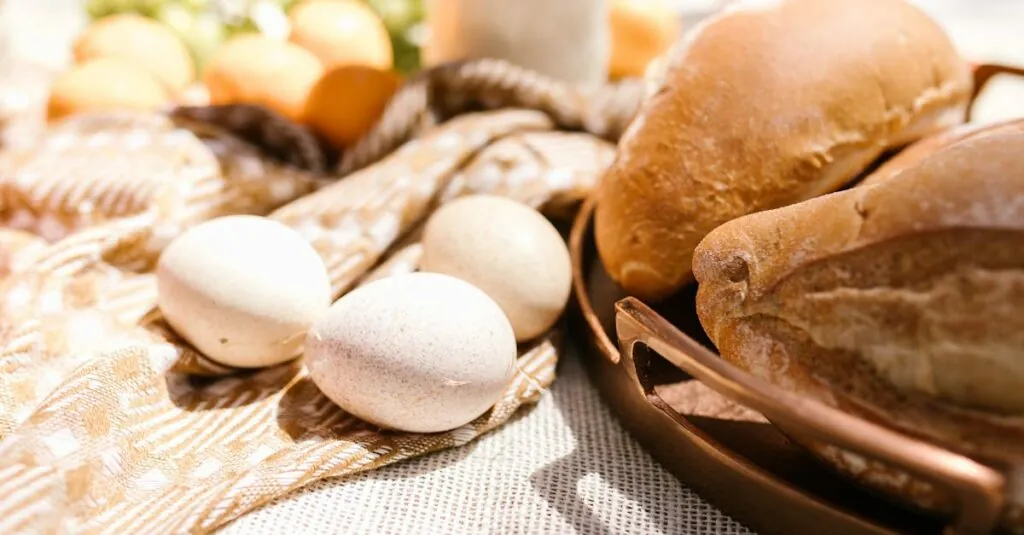Table of Contents
ToggleImagine sizzling steaks and fresh veggies right in your backyard, all while sipping a cool drink under the sun. A DIY outdoor kitchen island can transform any outdoor space into a culinary paradise. Not only does it elevate your grilling game, but it also turns you into the neighborhood’s BBQ hero.
What Is a DIY Outdoor Kitchen Island?
A DIY outdoor kitchen island serves as a functional and stylish addition to any backyard. It creates an outdoor cooking space that enhances culinary experiences. Homeowners design these islands to suit personal preferences and outdoor layouts.
Typically, the island includes elements like countertops, storage options, and cooking appliances. Materials vary from wood to stone, allowing for creativity in design. Features like grills and sinks make meal preparation convenient.
Building an outdoor kitchen island provides an opportunity for customization. Individuals choose dimensions that fit their yard without sacrificing space. Selecting colors and styles to match existing outdoor décor adds aesthetic appeal.
Consideration of local climate often influences material choice. Durable products withstand weather variations, ensuring longevity. Incorporating electrical outlets in the design allows for additional conveniences.
Many people view DIY outdoor kitchen islands as a cost-effective solution. Home improvement stores offer kits and resources, simplifying the building process. Online tutorials guide builders through each step, from planning to completion.
Functionality remains a priority when designing the layout. Seating areas can enhance social interaction, making the space more inviting. Thoughtful organization of cooking tools ensures efficient use of the island.
These versatile islands encourage outdoor entertaining throughout the year. Whether hosting summer gatherings or cozy fall evenings, the kitchen island adapts to various occasions. Employing smart design elements transforms an ordinary backyard into an outdoor oasis.
Benefits of a DIY Outdoor Kitchen Island
Creating a DIY outdoor kitchen island offers various advantages, enhancing both outdoor cooking experiences and home aesthetics.
Cost Savings
DIY outdoor kitchen islands greatly reduce expenses compared to professionally built options. Budget-conscious homeowners can save on labor costs by handling the project themselves. Choosing affordable materials, like treated wood or composite stone, further contributes to lower overall costs. Many home improvement stores offer pre-packaged kits, simplifying assembly and ensuring cost-effectiveness. Building outdoors often doesn’t require permits, leading to additional savings. Additionally, investing in energy-efficient appliances can lower utility bills over time. Many find this investment pays off in the long run with increased property values and enhanced outdoor enjoyment.
Customization Opportunities
Customization plays a key role in a DIY outdoor kitchen island’s appeal. Individuals can select colors, materials, and designs that align with their unique styles and outdoor spaces. Various layouts cater to different functions, accommodating both small gatherings and large parties. Homeowners frequently tailor features like countertops, grills, and storage options to maximize usability. Seasonal elements, such as weather-resistant materials, enhance durability and aesthetic appeal. Personal touches, like decorative accents, give the island a distinctive character. Overall, the freedom to customize not only enhances functionality but also integrates beautifully with existing outdoor decor.
Essential Features to Include
An outdoor kitchen island enhances the cooking experience with essential features that elevate functionality and convenience. Homeowners should focus on three main aspects: counter space, storage solutions, and cooking appliances.
Counter Space
Counter space plays a crucial role in outdoor kitchen islands. Ample surfaces allow for meal prep and serving, optimizing efficiency during cooking sessions. Materials like granite or concrete offer durability and visual appeal. Extended overhangs provide room for dining, encouraging social interaction. Designing the counter with various heights accommodates different activities, from grilling to cocktail mixing, ensuring versatility.
Storage Solutions
Efficient storage solutions enhance organization in an outdoor kitchen. Building cabinets for utensils and cookware helps keep space tidy, while drawers for spices and tools provide easy access. Open shelving can display decorative items or frequently used supplies. Weather-resistant materials enhance longevity, protecting items against the elements. Creative storage options, such as pull-out trash bins, improve cleanliness while maintaining a stylish look.
Cooking Appliances
Selecting the right cooking appliances is vital for an outdoor kitchen island. Grills, smokers, and pizza ovens cater to diverse culinary preferences. Choosing energy-efficient models reduces utility costs while boosting cooking performance. Incorporating sinks offers convenience for meal prep and clean-up, enhancing overall functionality. Outdoor refrigerators ensure easy access to drinks and ingredients, making entertaining effortless and enjoyable.
Materials to Use
Choosing the right materials for a DIY outdoor kitchen island significantly affects durability and aesthetics. Opting for weather-resistant options preserves functionality and enhances the overall look of the outdoor space.
Weather-Resistant Options
Concrete proves to be a durable choice, resisting moisture while providing a sleek appearance. Stainless steel appliances withstand rust and corrosion, ensuring longevity under various weather conditions. Composite decking offers a wood-like finish without the vulnerability of traditional wood materials. Tile surfaces contribute to water resistance and ease of cleaning, appealing to practicality. Lastly, using treated wood can prevent decay, maintaining the island’s beauty over time.
Budget-Friendly Choices
Reclaimed wood serves as a cost-effective option, showcasing character while reducing material expenses. Plywood provides a sturdy base at a lower price point, allowing for creativity in designs. Cinder blocks form a robust structure; they are inexpensive and easy to work with. Corrugated metal panels create an industrial look without breaking the bank, making them popular among DIY enthusiasts. Lastly, laminate countertops afford a stylish yet affordable surface, catering to various design themes while keeping costs low.
Step-by-Step Guide to Building Your DIY Outdoor Kitchen Island
Building a DIY outdoor kitchen island involves careful planning and execution. Follow these steps for a successful project.
Planning Your Design
Design begins with considering personal preferences and yard dimensions. Homeowners should sketch layouts that accommodate desired features like countertops, cooking appliances, and seating areas. Prioritize function while ensuring aesthetic appeal aligns with existing outdoor decor. Assess local climate conditions to make informed material choices. Identify any required utilities, such as water or electricity, and plan for them in the design.
Gathering Tools and Materials
Collecting the right tools and materials simplifies the building process. Essential tools include a circular saw, level, drill, and measuring tape. Gather materials based on chosen design, such as concrete, treated wood, or stainless steel. Many home improvement stores offer pre-packaged kits that simplify selection. Safety equipment, like gloves and goggles, ensures protection during construction. Organize tools and materials for easy access, enhancing efficiency throughout the building process.
Construction Process
Begin construction by laying a solid foundation to ensure stability. Assemble the frame according to the planned dimensions, securing pieces with screws or nails. Install countertops once the frame is complete, using weather-resistant surfaces for durability. Include any selected cooking appliances and storage solutions next, fitting them snugly into the design. Finalize by adding finishing touches, like paint or decorative elements, to enhance visual appeal and functionality. Regularly step back to assess progress, ensuring the finished product aligns with the original vision.
Transforming a backyard with a DIY outdoor kitchen island is a rewarding endeavor that elevates both cooking and entertaining. This project not only enhances the functionality of outdoor spaces but also allows for personal expression through design and customization.
By selecting the right materials and incorporating essential features, homeowners can create a stylish and practical cooking area that suits their lifestyle. The ability to save costs while enjoying the process makes this a popular choice among DIY enthusiasts.
Ultimately, a well-designed outdoor kitchen island can become the centerpiece of gatherings, making every meal an opportunity for connection and enjoyment.




